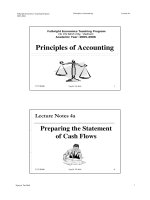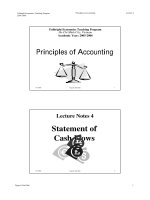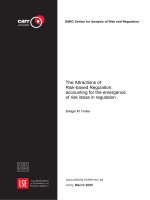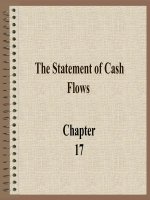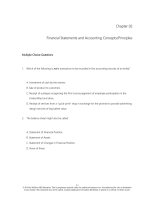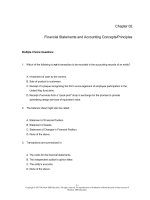Lecture Accounting: What the numbers mean (5/e) - Chapter 9: The income statement and the statement of cash flows
Bạn đang xem bản rút gọn của tài liệu. Xem và tải ngay bản đầy đủ của tài liệu tại đây (162.53 KB, 48 trang )
CHAPTER 9
THE INCOME STATEMENT
AND THE STATEMENT OF
CASH FLOWS
McGrawHill/Irwin
©The McGrawHill Companies, Inc., 2002
Learning Objectives
1. What is revenue, and what are the two
criteria that permit revenue recognition?
2. How is cost of goods sold determined
under both perpetual and periodic
inventory accounting systems?
3. What is the significance of gross profit,
and how is gross profit calculated and
used?
4. What are the principal categories and
components of “other operating
expenses,” and how are these items
reported on the income statement?
McGrawHill/Irwin
©The McGrawHill Companies, Inc., 2002
Learning Objectives
5. What is included in “income from
operations,” and why is this income
statement subtotal significant to
managers and financial analysts?
6. What are the components of the
earnings per share calculation, and
what are the reasons for some of the
refinements made in that calculation?
7. What are the alternative income
statement presentation models?
McGrawHill/Irwin
©The McGrawHill Companies, Inc., 2002
Learning Objectives
8. What are the unusual items that may
appear on the income statement?
9. What are the purpose and general
format of the statement of cash flows?
10. What is the difference between the
direct and the indirect methods of
presenting cash flows from operating
activities?
11. Why is the statement of cash flows
significant to financial analysts and
investors who rely on the financial
statements?
McGrawHill/Irwin
©The McGrawHill Companies, Inc., 2002
Learning Objective 1
• What is revenue, and what are
the two criteria that permit
revenue recognition?
McGrawHill/Irwin
©The McGrawHill Companies, Inc., 2002
Income Statement
• Answers important questions such as:
– What are the financial results of operations
of the entity for the fiscal year?
– Are sales increasing relative to cost of
goods sold and other operating expenses?
• Reports what has happened over a period of
time
McGrawHill/Irwin
©The McGrawHill Companies, Inc., 2002
Revenues
• Inflows or other enhancements of
assets from rendering goods or
services that constitute the entity’s
ongoing, major operations
• To be recognized, revenue must be:
– Realized or realizable
– Earned
McGrawHill/Irwin
©The McGrawHill Companies, Inc., 2002
Realization and Earned
• Realization – the product or service has
been exchanged for cash or claims to cash
• Earned – the entity has completed the
activities it must perform to be entitled to
the revenue benefits
• Both criteria are usually satisfied when
product being sold is delivered to the
customer
McGrawHill/Irwin
©The McGrawHill Companies, Inc., 2002
Sales
• Sales – describes the revenues of firms that
sell purchased or manufactured products
• Sales returns and allowances – a refund or
reduced price for defective merchandise
• Net sales – gross sales less sales returns
and allowances
• Other terms for revenues include Rental
Revenue, Fees, and Other Revenues
McGrawHill/Irwin
©The McGrawHill Companies, Inc., 2002
Shipping Terms
• FOB destination – the seller owns the product
until accepted by the buyer at the buyer’s
designated location. Title to the merchandise
passes when the merchandise is received by
the buyer. Seller incurs shipping costs
• FOB shipping point – buyer accepts ownership
of the product at the seller’s shipping location.
Buyer incurs shipping costs.
McGrawHill/Irwin
©The McGrawHill Companies, Inc., 2002
Gains
• Increases in net assets resulting from
incidental transactions or nonoperating
activities
• Not included with revenues at the
beginning of the income statement
• Reported as “other income”
McGrawHill/Irwin
©The McGrawHill Companies, Inc., 2002
Expenses
• Outflows or other using up of assets or
incurrence of liabilities from delivering goods
or services that constitute the entity’s
ongoing, major operations
• Based on the matching principle
• Some recognized in the period in which they
are incurred (administrative expenses)
• Others are an allocation of cost
(depreciation)
McGrawHill/Irwin
©The McGrawHill Companies, Inc., 2002
Losses
• Decreases in an entity’s net assets
resulting from incidental transactions or
nonoperating activities
• Not included with expenses on the
income statement
• Reported after “income from operations”
McGrawHill/Irwin
©The McGrawHill Companies, Inc., 2002
Learning Objective 2
• How is cost of goods sold
determined under both perpetual and
periodic inventory accounting
systems?
McGrawHill/Irwin
©The McGrawHill Companies, Inc., 2002
Cost of Goods Sold
• Most significant expense for many
manufacturing and merchandising firms
• Inventory shrinkage usually included
• Is a function of the inventory cost flow
assumption
• Computed as (under periodic system):
• Cost of beginning inventory + Net purchases
– Cost of ending inventory
McGrawHill/Irwin
©The McGrawHill Companies, Inc., 2002
Net Purchases
• Purchases are the inventory bought
for resale in a merchandising firm
• Freight charges are added
• Purchase discounts are deducted
• Purchase returns and allowances –
refunds or credits for defective
merchandise – are deducted
McGrawHill/Irwin
©The McGrawHill Companies, Inc., 2002
Expanded Cost of Goods Sold
Cost of beginning inventory
+ Purchases
+ Freight charges
- Purchase discounts
- Purchase returns and allowances
Net purchases
= Cost of goods available for sale
- Cost of ending inventory
= Cost of goods sold
McGrawHill/Irwin
XX
XX
XX
XX
XX
XX
XX
XX
XX
©The McGrawHill Companies, Inc., 2002
Learning Objective 3
• What is the significance of gross profit,
and how is gross profit calculated and
used?
McGrawHill/Irwin
©The McGrawHill Companies, Inc., 2002
Gross Profit or Gross Margin
• The difference between sales revenue and cost
of goods sold
• May be expressed as a dollar amount or as a
percentage of sales (gross profit ratio)
• A measure of the amount of each sales dollar
that is available to cover operating expenses
and profit
• Can be used to estimate cost of good sold and
ending inventory when physical inventory has
not been taken
McGrawHill/Irwin
©The McGrawHill Companies, Inc., 2002
Gross Profit Ratio
• Gross profit divided by sales
• Can be used to set selling prices
• Differs by class of merchandise sold
• Sales mix is the proportion of sales of
each class of merchandise
• Overall gross profit ratio depends on
the sales mix
McGrawHill/Irwin
©The McGrawHill Companies, Inc., 2002
Learning Objective 4
• What are the principal categories
and components of “other operating
expenses,” and how are these
items reported on the income
statement?
McGrawHill/Irwin
©The McGrawHill Companies, Inc., 2002
Other Operating Expenses
• Consists of:
– Selling expenses
– General and administrative expenses
– Research and development expenses
• Footnotes to the financial statements
often offer details about these expenses
McGrawHill/Irwin
©The McGrawHill Companies, Inc., 2002
Learning Objective 5
• What is included in “income from
operations,” and why is this income
statement subtotal significant to
managers and financial analysts?
McGrawHill/Irwin
©The McGrawHill Companies, Inc., 2002
Income From Operations
• The difference between gross profit and
operating expenses
• Most appropriate measure of management’s
ability to utilize the firm’s operating assets
• Excludes interest expense, interest income,
gains and losses, income taxes, and other
nonoperating transactions
McGrawHill/Irwin
©The McGrawHill Companies, Inc., 2002
Other Income and Expenses
• Includes interest expense, interest income,
gains, and losses
• Items that are not significant are reported
in “other income” and “other expenses”
• Nonoperating gains and losses include
sale or disposal of assets, losses from
inventory obsolescence, and litigation
gains and losses
McGrawHill/Irwin
©The McGrawHill Companies, Inc., 2002
